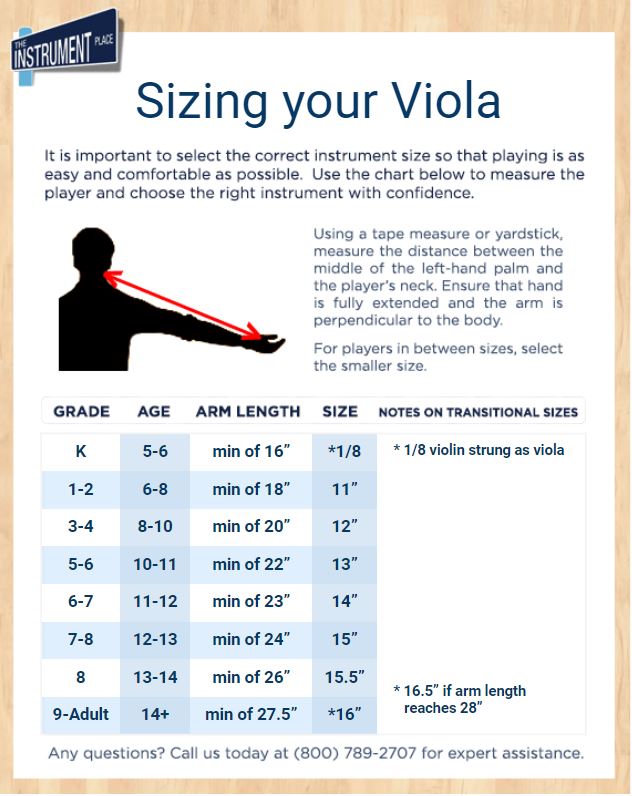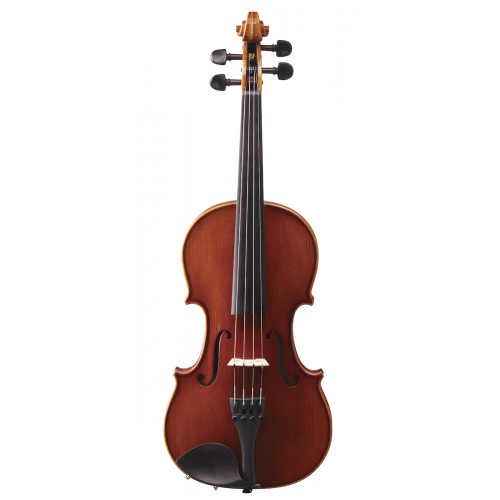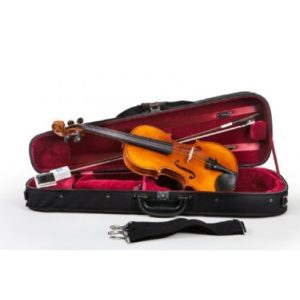Introduction
The viola is probably the oldest of today’s main stringed orchestral instruments, predating the cello, violin and string bass. However, it is easily the least familiar of the group.
They fill a vital role in arrangements, with a dark, deep tone and a range perfectly balanced between that of a cello and a violin. The viola’s range is a perfect fifth below that of the violin and one octave above that of the cello. The instrument’s size is about 30% larger than the violin and requires slightly more hand strength to play.
The viola’s role in compositional history is mostly as a harmonic instrument rather than a solo one. However, great violists and great solo viola repertoire are in plentiful supply today. Historic violas by famous makers such as Guarnerius and Stradivarius actually command higher prices today than their violins because of their relative rarity.
Which Viola Should I Choose?
The Orchestra Place requires all students to have an instrument from the teacher-approved brand list to ensure the best experience and sound for the student and the ensemble.
For beginners, we recommend Eastman Strings (Sizes 1/10 through 4/4) as the best viola for quality and affordability.
Eastman Strings Model 80 Student Viola
Founded in 1992, Eastman Music Company has established a reputation for their quality, traditional sound, and craftsmanship. Eastman is highly regarded for creating some of the finest instruments and accessories, and stands at the forefront of the creative development and marketing of musical instruments heard around the globe – making the reasonable viola prices for their products especially attractive.
Back to topHow to Choose the Right Viola Size for My Child
When selecting a viola for your child, size is extremely important. The instrument needs to feel comfortable and should not cause strain in the arm or neck. If your child feels at ease with their instrument, they will be much more likely to enjoy playing and want to stick with it. Size does not corresponds to skill level. Bringing home a full-size viola before they have grown into it can result in injuries including muscle strain and tendonitis. We recommend staying with a smaller-sized instrument until your teacher says your child is ready to move up.
If your child is matched with an instrument that is less than full size, you may want to consider renting until they grows into a full-size model. Below is a comprehensive sizing chart that takes into account age, grade level, and arm length.

How to Buy a Viola
After a young viola player has at least a year of experience, buying an instrument is often the best choice, financially and in sense of ownership. Your student has demonstrated their commitment and is ready to maintain and practice on their very own instrument. Since purchasing a viola is a bigger investment than renting, it’s important to make sure you’ve carefully compared retailers’ inventory, prices, financing options, setup and equipment options prior to buying.
There are a number of inferior instruments on the marketplace today that simply do not meet music program standards of performance for tone, technique, intonation, or reliability. Some of these violas are old and in need of retirement, but several new instrument brands fail in key areas as well. There is a difference in expectation between an instrument whose low price is obviously due to its age as opposed to a new “inexpensive” instrument. Most parents understand the risks they take with the former, but not with the latter. Vendors of these low-budget instruments are concerned with making a profit rather than supporting a quality music education. Music teachers frequently express concerns about the effects low-quality instruments have on students’ playing ability and confidence, and are justifiably concerned about the quality of each student’s instrument insofar as each one affects the sound of the ensemble. Many parents will make only one investment in an instrument, so choosing a quality viola is extremely important for many reasons.
Choosing a viola is a subjective process, but there are certain qualities any instrument you purchase simply must have. The viola must be the right size for your child and come with high-quality strings, protective case, and bow. When searching for a viola in a store or online, look for one that offers all the accessories you need as well, especially if they’re included in the cost of the overall instrument purchase. The most important areas to consider:
- Materials and method of construction. You won’t necessarily be able to tell this just by looking, which is where going with a trusted brand comes in. The maple or spruce used to make your instrument should be aged and air dried, and carved by hand rather than machine. Many poor-quality violas have been made with “green,” or premature, wood that is dried in a kiln and arched using moisture. Instruments should also have been varnished by hand, as thick varnish applied by machine may negatively affect resonation. Look only for instruments with ebony components: fingerboard, pegs, nut and saddle should all be made from high-grade ebony. Check for cracks and imperfections, which manifest as white or inconsistent grain. Beware of components that are described as “ebonized”–this indicates inferior hardwood that has been dyed to resemble ebony.
- False Advertisement. Many instrument descriptions include all the characteristics you’ve been taught to look for: “Solid spruce top, solid maple back, sides and neck, ebony fingerboard and pegs, hand-inlaid purling, Brazilwood or fiberglass bow with genuine horsehair…” Unfortunately, especially online, false advertising abounds. Often the components are inferior to their description. Even when the description is technically true, the materials may be of poor quality. Never buy a new viola under $350–if it sounds too good to be true, it is probably an “instrument-shaped object” rather than a quality viola. Some instruments in this category are so poorly made that teachers will not allow them in class.
- Investment over time. While it may initially be more expensive to purchase a viola that has been made by hand using quality materials and set up properly by an expert, over time you’ll save substantially when you don’t have to constantly repair and replace parts. If your child is committed to the instrument, consider making a larger initial investment that you’ll recoup in the coming years.
How Much Should a Viola Cost?
With violas as with all else, you get what you pay for. A viola that costs less than $350 is unlikely to deliver good sound or hold up after time. You may find yourself having to replace components and fittings, which will cancel out the low initial cost of the instrument. For a fully carved student viola with a quality horsehair bow and protective case, begin your search in the $400–$500 range.
Back to topRent-to-Own or Lease-to-Own Viola Options
Installment plans are an excellent option if you’re ready to make the commitment of buying an instrument but can benefit from deferred payments. This way, you get the freedom to pay over time, with the ultimate reward of owning the instrument. If you choose a rent-to-own or lease-to-own option, however, it’s important to check the fine print to make sure there are no hidden fees, and you should investigate the cancellation policy as well. Never sign up for a plan that traps you into payments if your child loses interest in playing an instrument. Look also for retailers who offer affordable damage protection during the installment term.
Our instrument supplier, The Instrument Place, offers teacher-approved instruments and one of the best interest-free lease-to-own programs as part of their commitment to getting an instrument in the hands of every person who wishes to play, without it being a financial burden.
Back to topFull Setup and Equipment for Violas
When comparing retailers, you’re sure to discover a large amount of variation in the set-up, maintenance, and equipment included in your purchase. Your vendor should always offer quality and consistency. Some things to look out for:
- Setup is key. The setup is perhaps the most important thing to consider when looking at a student-level instrument. A poorly set-up instrument can inhibit the student from learning technique and ultimately turn him off from the instrument altogether.
- All strings are not created equal. The caliber and adjustment of a viola’s strings makes a huge difference in sound and feel. Look for new, brand-name strings (e.g. Prelude, Dominant, Helicore) and maple bridges (e.g. Bausch, Despiau, Aubert). Check also for a quality tailpiece with four working tuners (e.g. Wittner). Unpropped or cheap bridges are unacceptable. The nut and bridge should be cut and set to a height that enables comfortable playing, as strings that are set too high may hurt your child’s fingers. Make sure also that the soundpost has been adjusted properly.
- Know your bow. The description “Brazilwood bow with genuine horsehair” may sound impressive, but inexpensive Brazilwood bows are often warped or very weak, and in fact all bows today use genuine horsehair. Look instead for a high-quality fiberglass or carbon fiber bow (e.g. K Holtz or Glasser), or for more advanced players, a Pernambuco wood bow. Any bow your child uses should be easy to tighten and loosen.
- Test the tailpiece. The tailpiece of a viola affects its sound greatly. Make sure the tailpiece has been installed so that it doesn’t create a buzzing sound when played.
- Protection is paramount. Protective cases are extremely important to the health of your child’s viola; before purchasing a viola, examine the case to make sure that all zippers and latches fasten securely.
- Brand matters. When buying stringed instruments, it’s always best to go with an instrument brand that is a known quantity. Although you may spend more in the outset, a quality brand-name instrument will save you countless maintenance, repair, and replacement costs over time. Look for brands that hand-carve each instrument individually and use materials of excellent quality in grade and preparation.
Recommended Viola Accessories
When buying a viola, look for a store that offers all the accessories your child will need in order to best use and maintain it. In addition to the case, bow, and rosin cake that should come with every purchase, you’ll need a shoulder rest and music stand. You may also want to consider buying a maintenance or care kit, which provides additional cleaning materials and practice aides. Some vendors will include some of these items as part of a violin outfit when you purchase the instrument, whereas others will charge extra.
Back to topViola Maintenance and Care
Like most musical instruments, the viola requires maintenance occasionally. You should expect a few broken strings from time to time. It just happens with violin family instruments. It is important to know how to care for your viola.
To keep your stringed instrument in the best condition, please follow these suggestions:
- Do not try and tune the instrument yourself! It takes a while to learn to do this properly, and if you’re not careful you may damage the instrument and/or break strings. Take your instrument to the teacher at your next class and have them tune it for you.
- Do not leave your instrument in your car! Intense heat or cold can cause an instrument to come apart or crack, and will definitely cause it to fall out of tune. Also, try to avoid exposing your instrument to sudden changes in humidity. When traveling with your instrument it is always better to keep it in the back seat of your car rather than the trunk.
- Keep your instrument clean. Keep a lint-free cloth inside your case and wipe off all the rosin dust and dirt from your instrument after each time you play. Pay particular attention to the fingerboard and the top of the instrument. Be careful not to knock the bridge out of place. NEVER USE FURNITURE POLISH OR ALCOHOL TO CLEAN YOUR INSTRUMENT.
- Always keep your instrument and bow in its case with the lid closed when not in use. Also, be sure that you securely lock the bow in place and remove the shoulder rest or pad before closing the case. Careless accidents could leave your instrument seriously damaged.
- If the same string breaks often, have your repair person examine the viola to make sure something is not out of adjustment.
- Upgrading to perlon core strings can give a viola a much more pleasing tone, and is often worth the investment.
- Viola bows need to be re-haired every year or two depending on the amount of playing.
Student viola prices can be considerable so take care of your instrument. Every viola player should have a maintenance and care kit.
Back to top

